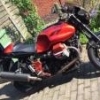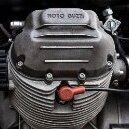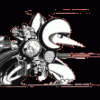-
Posts
342 -
Joined
-
Last visited
-
Days Won
6
Tinus89 last won the day on March 15
Tinus89 had the most liked content!
About Tinus89
- Birthday 07/27/1989
Profile Information
-
Location
Groningen, Netherlands
-
My bike(s)
V11 Sport Mandello Rosso, Aprilia Tuareg 660, V65 Florida (build in progress)
Tinus89's Achievements

Guzzisti (2/5)
215
Reputation
-
I am no electrics guy, so I may not understand, but what I meant is essentially what GuzziMoto wrote: I think that an added resistor (instead of the bulb) will protect the thermistor and therefore safeguard the intrinsically safe system in the tank, but I think even with the high resistance of thermistor & resistor, the current flowing is still enough to light the LED. As the LED lights with the thermistor cold (and ~ 1800ohm - I have not measured yet), it will most likely also light with the 1800+150ohm resistance... However, would switching the LED through a 100mA relay not work? Something like this (https://www.diverseelectronics.com/upload/documents/SARA.pdf), which can only close at ~100mA (which almost lights the incandescent bulb). I would suppose the coil in the relay would still allow some current to flow for the thermistor to heat up & keep it's function. Also, are we confident this fuel gauge works with a thermistor as well? Because it has a small "float" as can be seen on the picture: Keeping the stock bulb is not an option. I have a set of LEDs nicely built into the handlebar clamp, the incandescent bulb simply does not fit there. Making an electronic solution is less work than going back to the original bulb...
-
The original bulb is 1.2W. But I am failing to understand how this would work. Adding a resister similar to the 1.2W bulb would only "help" the fuel level sensor in not becoming too hot, right? Would it, in "full" position, still not allow sufficient current to flow through the high resistance in the fuel level sensor to light the LED bulb?
-
On my V65 Scrambler, I changed all the bulbs (and the whole dash) for LED's. My tank came with a level sensor which I think (but will have to take those measurements) works the same way. This is the gauge: https://www.stein-dinse.com/en/nml-moto-guzzi-petcock-electrically-left-side-mille-gt-sp/item-2-1084757-23105370-.html So obviously I discovered the light is always on. Reading your story, would installing a properly sized resistor in series with the fuel gauge be an option, with the LED parallel to the resistor?
-

(ex) V65 Florida no start after changing headgaskets
Tinus89 replied to Tinus89's topic in Older models
Lovely (potential) ladies and gentlemen. White smoke. The issue has been found! Long story short, I have been changing components left/right so many times now, I lost the baseline. During this process, I had an intermittend spark, which in turn was intermittend again. I got frustrated, cursed, wanted to push the bike into a canal. Decided to start over. Begin at the base I was left off with (which was with the signal wires of the pickup crossed). Put some fuel in her, had a huge backfire (remember the crossed wires?) But hey, the size of the backfire was new. Switched the wires back and BOOM. Started up "like a dream" But why? And then there was it. I had already abused one lithium battery to failure. In the process of getting the fueling so that she would start quick, I jumpered the battery of my V11 onto her. I only used the engine ground (and not the central ground point cable I also engineered into it) and she ran fine (before the head gaskets). The only thing that changed between the last no-run-with-fuel and yesterday's baseline attempt, was I added a central ground wire. I never looked into that because she ran fine without it earlier. Started the bike, removed the ground cable and she died. Repeated 4 times without failure. So yeah, the luck of the bike running without that main ground, turned into a big search later. The real story? I sold my Caponord 1000 two months ago to a friend. Yesterday I received my Aprilia Tuareg 660 AND found out the above. Moral of the story? I just needed a new bike Thanks everyone for thinking along! -

My engine is pinging when loading it, above 4000 rpm...
Tinus89 replied to p6x's topic in Technical Topics
My V11 pinged in the 4000-5500rpm range during warmer weather and WOT. She is equipped with pod filters (PO did that, I like the sound so I keep them). I solved the problem by (in steps) increasing the fueling using Guzzidiag and Tune ECU ( I thought that was the software, but could have been the Aprilia Caponord as well) in that area slightly. -
Dismantle the starter and look inside. I am 99% sure you will see one or more loose magnets. I had the EXACT same symptoms. Replaced the battery, no change. Until I disassembled the starter itself and found one magnet laying loose. Roadside assistance helped me hook up a van battery (like a huge car battery), and the dead short in my starter pulled the van battery down to 7v!! After a few taps on the starter (which most likely relocated the magnet) she started up like nothing ever happened.
-

(ex) V65 Florida no start after changing headgaskets
Tinus89 replied to Tinus89's topic in Older models
Yes, it is. I have been fiddling with the ignition for a while now. Somehow, the spark seems a bit weak now (not before) and the left side is not always sparking. I am currently away from home for work, but when I get back, I will investigate further. So far it seems like the problem is most present on the left cilinder. When changing the ignition CDIs, coils (plus leads/caps) and even the pickup, the problem remains on the left side the most. I will have to re-investigate the ignition parts & wiring from the start when I get back. -

(ex) V65 Florida no start after changing headgaskets
Tinus89 replied to Tinus89's topic in Older models
As my flywheel mark is incorrect (due to orientation), I positioned the right cilinder at TDC compression stroke (so after the intake valve closes). I then marked the flywheel 7deg BEFORE TDC. The 7deg is based on the distance between the two marks (there are two for each TDC). I then tried starting the bike whilst checking with a strobe light on the right cilinder. There was some scatter (starter motor working against compression) but the timing seemed correct. I also checked spark with the spark plug out & against the block, nice strong spark. Believe me, time & patience have been in abundance (> 2 weeks already), so therefore I am asking on this forum for the fresh set of eyes now:) The carbs have stayed on the bike, I just loosened the rubber boot. They have been rebuilt with new parts 2 years ago & I have checked the jets are clear after the non-start issues. Throttle cables are OK & have free play. Choke pistons OK. Also, I tried starting the bike with the choke float bowls empty (and fuel shut off) whilst spraying brake cleaner into the carbs, but even then she does not want to run. Therefore I don't really suspect the carbs anymore. To me it sounds like timing as well, but I can't explain what has changed when changing the head gaskets. I have checked the timing with the strobe light as indicated earlier in this message. Carbs are PHBH30 -

(ex) V65 Florida no start after changing headgaskets
Tinus89 replied to Tinus89's topic in Older models
Nope, no luck. So the classic point system has been replaced by Carmo electronic ignition. The mechanical advance is gone, there is an electronic pulse generator on the end of the camshaft like this one: I do suppose this could have become contaminated, because the storage location of the bike is also used for other stuff (occasional spray paint, metalwork) so I could clean it up properly. -

(ex) V65 Florida no start after changing headgaskets
Tinus89 replied to Tinus89's topic in Older models
Excellent question! Yes I did, and the adjumstment required was only minimal (set to 0.15 / 0.20mm). Updated the opening post as well. -
Hi all, I have a V65 Floriday which I converted to a scrambler. Different exhaust & pod filters. Yes, I know they are bad for performance. My experience tuning carburetor bikes is very limited, so I may not have set her up correctly. After the rebuild, I stepped the main jet from 105 to 115. With adjusting the needle heights up (more fuel) the throttle response improved, so I went up in size to 128 an tried the same. Again improvement, so I went up to the next size I had available (145). With the needles all the way down, the throttle response was perfect. Quick and without hesitation. Tried starting her cold the next day, no issues. I then changed the head gaskets (both were the cheap version & wheeping) and since then, I cannot get her started anymore. I have not touched any of the wiring in the process. The bike is equipped with Carmo Electronics electrical ignition and "wants to run" (plopping in the exhaust). Sometimes during starting the starter suddenly stops as if she tries to fire whilst on it's way up on the compression stroke. Checked/adjusted: - Spark (good strong on both sides) - Spark timing (created mark on flywheel as flywheel appears to not be installed in the correct orientation) for RHS TDC - +/- 7deg, checked with strobe OK - Went back to jet size 128, 115 and eventually 105 (original) - Changed spark plugs for new - Compression both sides 13.5bar - Switched spark plug leads left/right (no "trying to run" anymore when switched) - Adjusted mixture screw anywhere between 1/2 turn and 4 turns (manual states 1,5 turns out) - Adjusted idle screw up/down - Emptied float bowls & tried to start her with brake cleaner, same result (only popping, no running) - Removed air filters, no change After AudioMick's response: - Checked & adjusted (only minimal change required) valve clearance after head re-torqueing. Observations: - When I remove the carburetors, there is some stagnant fuel in the inlet - Sometimes the spark plugs are wet, sometimes not - When I open the throttle or the choke, she "does not want to run", popping in the exhaust goes away like she gets too much fuel - It is almost like the new headgaskets have changed something, or the ignition timing is off - Sometimes she fires against the starter motor, so the starter stops briefly. - Sometimes she fires in the inlet, but only a little bit (no loud bang or backfire) I am at a loss, so are some of my friends who have been trying to help me. What am I missing? Could the head gasket replacement have gone wrong?
-
About two months ago I gave her a service, including solving the wheep from the gearbox exit shaft seal. Discovered the seal was not installed all the way, so instead of replacing it, I tapped it a bit deeper. Then the wheep turned into a leak. So I went in again and disassembled the rear AGAIN, this time to replace the seal. Oh well....
-
So because of a huge house renovation, I have not had a lot of time to ride my Italian bikes However, the previous car was increasing in maintenance (and a diesel, which was not the right choice anymore), so I wanted something else. And well, the Italian blood was already there, so I bought my 4th Italian vehicle, this time with 4 wheels.
- 353 replies
-
- 13
-

-
"Sold the V11, bought a different bike". Really? Well sort off... I have always admired the look of the V11 with the higher mounted Titanium exhausts, and once came very close to buying a pair, however they were damaged and I liked the look of the original carbon-fiber ones on my Mandello Rosso better. So when a member on here offered a set of carbon high-mount Gianelli's for sale, I went for it. He also threw a Stucchi crossover into the deal (thanks Crazyhorse!). Mounted them last Tuesday. Oh my, what a sound! Not much louder, but a whole lot deeper. But, did I imagine it revving much quicker between 3000 and 5000 rpm? Went for a ride. I'm not sure how much is to contribute to the Gianelli cans or to the Stucchi crossover, but WHAT a difference in mid-range pull! From 3000rpms onwards she just goes and goes. Like I bought a different bike.
-
Phil is correct, and I also noticed this. So I took a seal driver and drove the seal 3mm deeper into the gearbox case, causing the dust lip to now also remain on the sealbore on the shaft. I did order a replacement seal, but will keep this on stock for now as it was more of a wheep than a leak. Thanks for all the comments!







